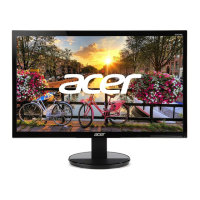
Do you have a question about the Acer K242HQL and is the answer not in the manual?
| Color | black |
|---|---|
| Screen Type | led |
| Tiltable | yes |
| Wall Mount | 100mm x 100mm |
| Touch Screen | no |
| Webcam | no |
| OS Compatibility | windows |
| Screen Size | 23.6 inches |
| Panel Type | tn |
| Aspect Ratio | 16:9 |
| Resolution | 1920 x 1080 |
| Native Resolution | 1920 x 1080 |
| Refresh Rate | 60hz |
| Horizontal Viewing Angle | 170 degrees |
| Vertical Viewing Angle | 160 degrees |
| Response Time | 5 milliseconds |
| Brightness | 250 candela per square meter |
| Contrast Ratio | 100, 000, 000:1 |
| Synchronization | not applicable |
| Horizontal Scan Rate | 80 kilohertz |
| HDR | no |
| Built-In Speakers | no |
| VGA Ports | 1 |
| DVI | 1 |
| Headphones Output | no |
| Power Saving Mode | 0.35 watts |
| Depth with Stand | 8.2 inches |
| Width with Stand | 22.3 inches |
| Depth without Stand | 2.4 inches |
| Height without Stand | 13.2 inches |
| Net Weight without Stand | 9.4 pounds |
General safety advice and precautions for users.
Guidelines for cleaning and connecting/disconnecting the device.
Warnings, safe listening, electrical power usage, and accessibility.
When to seek service, handling explosive environments, and recycling.
Proper disposal, pixel statement, and tips for comfortable use.
Finding comfort zone, posture, and protecting eyesight.
Tips for display settings, reducing glare, and developing good work habits.
Manufacturer's statement of compliance with relevant directives.
Statement confirming compliance with Federal Communications Commission rules.
Checking package contents and preparing for setup.
Steps to attach the monitor base and adjust screen position.
Connecting power cord, DDC, and understanding power saving.
Pin assignments for display signal cables.
Supported resolutions and refresh rates.
Step-by-step guide to connecting the monitor to a computer.
Explanation of power button, LED, and shortcut menu buttons.
Detailed guide to Acer's eColor Management system modes.
Adjusting picture quality, OSD position, and general settings via OSD.
How to view current input and device information.
Common problems and solutions for VGA connections.
Troubleshooting steps for DVI and HDMI connections.